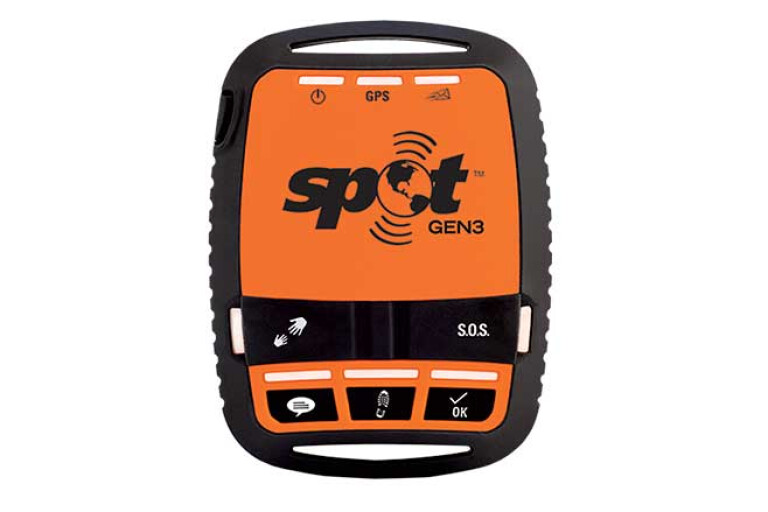
LET’S be honest, most of us are glued to our mobile phones – checking Facebook periodically, calling friends or using mapping software, among a long list of addictions – but your mobile phone will be as useful as a rake pushing water uphill when you’re out beyond the black stump.
Once off the grid, you’ll need another means of communication. Even if you want to head to remote country for the isolation and peace and quiet, it’s still essential to pack a comms tool in case the proverbial hits the fan.
The options include an HF radio, satellite phone, a satellite messenger or personal locator beacon (PLB). Here, we dive into the world of satellite messengers, by speaking to the folks who produce them.
A satellite messenger differs from a satellite phone as it allows the user to send and receive messages; a satellite phone, on the other hand, will, in addition to sending/receiving messages, allow voice calls to be made. A satellite messenger is usually smaller and lighter and won’t hit your hip pocket as hard as most are considerably cheaper than satellite phones. Some satellite messengers also include SOS functionality.

“A simple way to think about it is, a satellite phone keeps you in touch and a satellite messenger keeps you safe,” said Kieran Blakemore, marketing manager at Pivotel, the distributor of SPOT products.
As the name implies, a satellite messenger can send preset or customised text messages (which can be emergency-related or just for staying in touch with family and friends), and also offer tracking features so that contacts can follow geotagged signals sent at predetermined intervals. However, the satellite messengers on the market all differ in features and functionality, as you’ll read later.
Much like a satellite phone, a satellite messenger must connect to a satellite network to function, and it needs to be used with a clear, open view toward the sky.
“The satellite must be able to see the device and the device to see the satellite to operate,” said Reiny Gajewski, VP of global sales for Beam Communications. “Once they have connection, the messages are sent back and forth over the satellite network to the public phone network and then to their destination.”
We’ve taken a microscope to examine a few satellite messengers currently on the market: the Garmin inReach, Iridium GO!, ZOLEO, SPOT X and SPOT Gen3.
FEATURES TO LOOK FOR
PLANNING that post-lockdown adventure? Here’s what to research when hunting for a new satellite messenger: Cost (low ongoing plans, with suspension options); comprehensive network coverage (satellite constellation, to determine where in the world you can use the device); simple and easy operation; the ability to send and receive messages (some are one-way only); battery life; high IP rating (so it can go wherever you go); good warranty period; portability; and an SOS feature.
“Whenever travelling with a satellite messenger, it is recommended to have a secondary source of power such as spare batteries or a solar charger, ensuring you can recharge your device in the event of an emergency,” added Kieran Blackmore.
WHY NOT JUST USE A PLB?
A PERSONAL locator beacon is a one-way device you can trigger only in an emergency, to send your co-ordinates to the emergency services. Simply hit the SOS button and wait. The only issue is that with most PLB devices, you won’t get confirmation that your message was received – sure to drive up stress levels for anxious folk.
“Satellite messengers also offer communication capabilities with friends and family, as well as the ability to communicate with rescue services which enables users to advise what their status is,” Garmin Australia’s general manager, Matthew Thomas, told us. “They also allow them to receive information from emergency services such as first-aid advice and expected time of rescue.”
“It’s important to note a satellite messenger cannot replace a PLB in a situation where you’re required to carry a PLB,” added Kieran Blackmore.
SPOT GEN3
THE SPOT Gen3 is an entry-level messenger that provides simple one-way communications, allowing it to send SOS, HELP and OK messages. Unlike the brand’s recently released SPOT X, the Gen3 is designed for tracking and safety purposes only.
“If you only need something that is going to keep you safe in the event of an emergency, then the SPOT Gen3 is a good option,” said SPOT’s Kieran Blackmore.
The Gen3 is fairly rudimentary in its operation, using replaceable lithium AAA batteries as its power source. The batteries are said to provide up to three months of standby power and can send 1250 messages on a single set of batteries, but always have a spare set stored just in case.

The Gen3 has an operating temperature range from -30˚C to 60˚C, with an operating altitude of -100m to +6500m. With an IP67 rating, the Gen3 also has a waterproof rating of one metre for up to 30 minutes. It measures at 87.2 x 65 x 25.4mm and weighs 114g (with batteries). As the Gen3 is fairly long in the tooth, it doesn’t have Bluetooth functionality.
Like the SPOT X, the Gen3 uses the Globalstar satellite network, which is a low earth orbit constellation made up of 48 satellites providing coverage across Australasia.
Ron Moon used the SPOT Gen3 on a Victorian High Country trip a few years ago. Here’s what he said about the product at the time: “A very handy and easy-to-use safety device that could save your life if lost or broken down in a remote area. Cheaper than a satphone or an HF radio!”
RRP: $239
WEBSITE: www.findmespot.com
SPOT X
THE X is SPOT’s latest addition to its range of satellite messengers, but unlike the Gen3 it has two-way functionality, allowing the user to send and receive custom text messages via SMS and email.
“The SPOT X provides a good balance between safety and messaging functionality, but those with a more constrained budget will find the SPOT Gen3 a more economical option,” said Kieran Blackmore.
At approximately double the price of the Gen3, the X brings considerably more to the table, with an internal lithium-ion battery (in conjunction with a low-power screen) high on its list of features. This combination allows the SPOT X to operate constantly at 10 minutes (tracking) for up to 10 days. The unit’s battery is said to have 240 hours of battery life (in 10-minute tracking mode).

The X weighs more than the Gen3 (at 198.4g), has an operating temperature of -20˚C to 60˚C, an operating altitude of -100m to 6500m, and is impact-, water- and dust-resistant with an IP67 rating (submersible up to one metre for 30 minutes). The X also features has a physical QWERTY keyboard, while other devices require you to use an app to message, or have an on-screen keyboard you access with a Navi-Key.
In-built Bluetooth functionality is a difference between the X and the Gen3, with Bluetooth providing the option to download the SPOT X app to your smartphone and use it as the satellite messenger interface rather than the device itself. Much like the Gen3, the X uses the Globalstar satellite network.
RRP: $469
WEBSITE: www.findmespot.com
GARMIN inREACH
GARMIN has a range of satellite messengers on the market, ranging in price from $529 (Mini) to $949 (GPSMAP 86i).
The Mini is the entry-level unit within the Garmin range and features two-way messaging, two-way global interactive SOS, tracking and location sharing, cloud storage, trip planning, and weather info. The Mini weighs a lithe 100g and measures in at 5.2 x 9.9 x 2.6cm. The rechargeable internal lithium-ion battery provides up to 50 hours of life (at 10-minute tracking with five-minute logging).
4X4 Australia’s former deputy editor, Dean Mellor, tested the inReach Mini and said of it: “Here was a two-way satellite communicator that cost much less than a satphone to purchase and operate, yet it allowed for text communication from anywhere in the world. Better yet, by downloading an app and connecting to my phone via Bluetooth, it would be super-easy to use.”
The SE+ is the next step up and also includes two-way messaging, interactive SOS functionality, cloud storage and trip planning, weather information, navigational features, and can be paired with mobile devices. It adds a QWERTY keyboard for customised text entry. The Explorer+ then adds preloaded topographic maps and built-in navigation sensors (compass, barometric altimeter and accelerometer).

The SE+ and Explorer+ utilise an internal, rechargeable lithium battery that provides up to 100 hours of battery life (in tracking mode). Both weigh 213g and measure in at 6.8 x 16.4 x 3.8cm.
The GPSMAP 66i and GPSMAP 86i are the premium offerings in the Garmin range; though the 86i has been designed mainly for boating and water use. In addition to interactive SOS and two-way messaging, the premium 66i features a Livetrack function (share your co-ordinates with loved ones) and Topoactive maps in the form of direct-to-device BirdsEye Satellite Imagery downloads. Other notable features include a three-inch colour display, and an LED flashlight and beacon. The 66i weighs 241g (with batteries) and measures 6.6 x 16.3 x 3.5cm.
All devices are housed in an impact-resistant, water-rated construction, with an IPX7 water rating. All Garmin satellite messengers communicate through the Iridium satellite network, which provides global coverage including all areas of Australia.
Bluetooth-compatible Garmin devices are synced to the Earthmate app, providing easy access to unlimited maps and aerial imagery. The Earthmate app also allows you to conveniently use all of the inReach features on your paired mobile device.
“For easier messaging, you can also access your phone’s contact list from the Earthmate app to connect with fewer keystrokes. One great example of Bluetooth functionality is staying warm inside your hut or tent while placing the inReach device outside and messaging from your phone,” Matthew Thomas said.
RRP: $529 InReach MINI; $599 InReach SE+; $699 InReach Explorer+; $899 GPSMAO 66i
WEBSITE: www.garmin.com
ZOLEO and IRIDIUM GO!
THE ZOLEO communicator is a device that simply extends your smartphone’s messaging coverage by transmitting over satellite, mobile and WiFi, so that it continues to work when you leave the bright lights of the city.
The key to the ZOLEO is a free mobile app that syncs the unit via Bluetooth to a smartphone, through a simple set-up process.
Utilising the Iridium network, the ZOLEO app incorporates an SOS function with 24/7 monitoring and response, as well as a dedicated Australian SMS number and email to share with contacts. ZOLEO allows anyone to message you directly without the need to message them first. ZOLEO supprts 900+ character app-to-app messaging; 160 character SMS; and 200 character email.

An in-built check-in button notifies contacts you’re okay and that you’ve arrived at your destination in one piece. The ZOLEO app also features DarkSky, one of the most accurate sources of hyperlocal weather.
“A satellite messenger like ZOLEO is smaller and lighter, has a long battery life of 200+ hours, and it works with your smartphone so it’s easy to use,” said Reiny Gajewski. The units weighs 150g and its small stature measures 9.1 x 6.6 x 2.7cm.
The Iridium GO! works in a similar way to the ZOLEO, in that it allows the user to communicate via a smartphone when cellular coverage is unavailable. When paired to a smartphone via WiFi, the GO! allows the user to make phone calls and send messages via the Iridium satellite network and can support up to five smart devices at any one time.

The ZOLEO is IP68 rated, and it’s shock-, dust- and water-resistance (to 1.5m for 30 minutes). The unit is powered by a rechargeable internal lithium-ion battery that boasts a life of more than 200 hours. The GO! unit weighs 304g and measures just 11.4 x 8.2 x 3.2cm. The unit is IP65 rated.
RRP: $345 (ZOLEO); RRP: $1145* (GO!) *sold by many stockists
WEBSITE: www.beamcommunications.com



COMMENTS